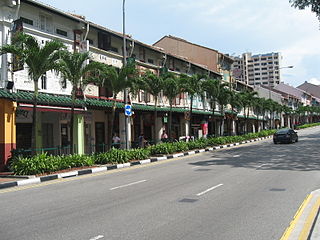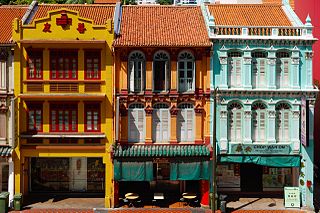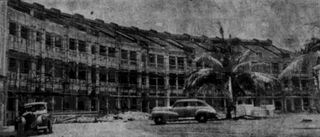Related Research Articles

Boat Quay is a historical quay in Singapore which is situated upstream from the mouth of the Singapore River on its southern bank. It spans from the shophouses near UOB Plaza, stretching along one bank of the Singapore River, all the way till Elgin Bridge.

The architecture of Singapore displays a range of influences and styles from different places and periods. These range from the eclectic styles and hybrid forms of the colonial period to the tendency of more contemporary architecture to incorporate trends from around the world. In both aesthetic and technological terms, Singapore architecture may be divided into the more traditional pre-World War II colonial period, and the largely modern post-war and post-colonial period.

Neil Road is a one-way road in Chinatown and Tanjong Pagar in the planning areas of Outram and Bukit Merah in Singapore. The road starts at the junction of South Bridge Road, Maxwell Road and Tanjong Pagar Road and ends at Kampong Bahru Road which then merges into Jalan Bukit Merah. At the end of the road, it is a conservation area of several shophouses and a three-story Victorian style school building, which was the former site of Fairfield Methodist Girls' School. In the Tanjong Pagar area of the road, it is home to rows of conserved shophouses for various purposes.

Keong Saik Road is a one-way road located in Chinatown within the Outram Planning Area in Singapore. The road links New Bridge Road to Neil Road, and is intersected by Kreta Ayer Road.

Golden Mile Complex is a high-rise commercial and residential building on Beach Road in Kallang, Singapore. Within walking distance to Nicoll Highway MRT station, the building was formerly known as Woh Hup Complex. Prior to collective sale, the complex contained 411 shops and 500 parking spaces. The building was largely an ethnic enclave for the Thai population in Singapore.

Sino-Portuguese architecture, also known as Chinese Baroque,Straits/Singapore Eclectic architecture or Peranakan architecture is an Asian hybrid style incorporating elements of both Chinese and Portuguese architectural styles. It is common in urban centers where Chinese settlers lived in southern China and the Peranakans of the Malay Peninsula, with examples found and most prominently conserved and maintained in Singapore.
The Balestier Art Deco shophouses are two shophouses located on 230 & 246 Balestier Road in Balestier, Singapore.

Atbara House is an historic house on Gallop Road in the Singapore Botanic Gardens. It is often regarded as the first Black and White House in Singapore, despite it not actually being a black and white house.
593 Serangoon Road is a shophouse on the corner of Serangoon Road and Balestier Road. It previously housed the Singapore Institute of Science and currently houses the Sin Peng Lounge.
72-13, formerly the Bank of China No. 3 Warehouse, is a former Bank of China warehouse at the corner of Mohamed Sultan Road and Caseen Street within the Singapore River Planning Area. It currently houses The Curators Academy and Theatreworks.
Inverturret, also known as 7 Gallop Road, is a historic bungalow in the Gallop Extension of the Singapore Botanical Gardens. Previously the residence of the Air Officer Commanding the Far East Air Force and the residence of the French consul-general, the bungalow currently houses the Botanical Art Gallery.
733 Mountbatten Road is a bungalow on Mountbatten Road in Marine Parade, Singapore.
Temasek Shophouse is a building on Orchard Road in the Museum Planning Area of Singapore. Completed as a townhouse in 1928, it presently serves as a "social impact hub".
Beulah House is a bungalow on Gilstead Road in Novena, Singapore. It housed an eye clinic before it was acquired by the Life Bible-Presbyterian Church in 1990.

Chee Guan Chiang House, also known as the Wellington House, is an abandoned bungalow on Grange Road in River Valley, Singapore. Built in 1938 for Chee Guan Chiang, the son of Chee Swee Cheng, it served as a guest house for several years before it was left vacant.
2 Cable Road is a bungalow on Cable Road in Tanglin, Singapore. Completed in 1913, it was built for Municipal Commissioner Mohamed Namazie.
145 Neil Road is a shophouse on Neil Road in Bukit Merah, Singapore. It was gazetted for conservation as part of the Blair Plain Conservation Area.

Sea Breeze Lodge is a historic bungalow in Marine Parade, Singapore. Completed for businessman Choa Kim Keat in 1898, the building initially stood along the seaside. It is the last remaining bungalow along Marine Parade Road to have been built before reclamation works shifted the shore away from the road.

Meyer Road is a primary access street in Katong, Singapore. Named in 1921 after Sir Manasseh Meyer, it stretches from Tanjong Rhu Road to Tanjong Katong Road at a length of 1.4km. It is connected to many prominent past and present landmarks such as Katong Park and formerly the Crescent Flats and Meyer Flats as well as Katong Park Hotel. It is nicknamed "the Little India of East Coast" due to the large number of Indian residents living there.

Crescent Flats, also known as The Crescent, was an apartment building on Meyer Road in Katong, Singapore. Completed in 1912, it is believed to have been the first apartment building built in Singapore. Designed by Regent Alfred John Bidwell for Manasseh Meyer, both the building and the neighbouring Meyer Flats, built as a companion block, were demolished to make way for a condominium project.
References
- ↑ Sajan, Chantal (20 August 2021). "Little-known architect E.V. Miller said to have worked on Meyer Road house". The Straits Times . Singapore. Retrieved 10 August 2024.
- 1 2 3 4 Sajan, Chantal (21 August 2021). "How 'Mr Toilet' Jack Sim turned a ramshackle house into a bungalow worth $13 million". The Straits Times . Singapore. Retrieved 10 August 2024.
- ↑ "Seaside school". The Straits Times . Singapore. 8 February 1981. Retrieved 10 August 2024.
- ↑ "Meyer Road no. 30 : general view [1]". nlb.gov.sg . National Library Board . Retrieved 10 August 2024.
- ↑ Lai, Alvin (10 November 2005). "The fort that Jack rebuilt". The Straits Times . Singapore.